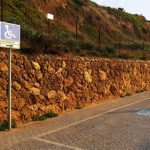Why visit Ephesus? These ruins are one of the world’s largest excavated ancient Greek/ Roman/ Christian cities. Everyone I spoke to said it was a must-stop if you are in Turkey. Cappadocia, the other must-see place, is far from Turkey’s eastern interior. Plus I found no information as to how wheelchair accessible it is. Thus my mom and I decided to stay out west along the coast.
You have to commit and plan to go to Ephesus. It is well away from Istanbul and other major Turkish sites. It is not along a major transit route. Many come by a cruise ship that stops nearby. I flew and stayed in Izmir, Turkey‘s third-largest town. It is an hour away by car. (As an aside: I had heard drab things about Izmir but it was surprisingly lovely. The waterfront was recently redeveloped and it just felt like a city with a nice scale. It is a non-touristy Turkish city and feels fully European.) As of Spring 2014, the town seemed to be in the midst of a building boom, so there seemed to be a number of choices for modern hotels. I stayed at the Grand Hyatt, which had wide enough bathroom doors that I didn’t use an “accessible” room. The room had no additional modifications. The hotel was very modern so assume there were “accessible” rooms with a roll-in shower. Other modern hotels in Turkey on this trip did. But I never looked into them here.
Exploring Ephesus
Everyone comes to Ephesus by tour bus, taxi, or hired car. I came by hired sedan car arranged by the hotel. I did no research for other wheelchair friendly transportation options. The length of the walkable grounds are roughly a mile and a half long. Very succinctly 75% was manageable and the other 25%, in a middle stretch, was too treacherous for me. The park’s pathway is mostly 4×4 wood rails laid down along side each other. The other stretches are large marble slabs and modern cobblestones. This means it is bumpy but an even, rhythmic bumpy. And all of this is flat or on a mild grade. The too treacherous part for me in the middle was on a grade, rough, uneven, and irregular stone path.
There are entrances at each end of the park—a larger northern entrance and a southern hills entrance. If you enter at the north entrance, you will see 50% of the grounds before it get impassable. This part includes the amphitheater and the iconic reconstructed library facade. After that the path gets tough. I backtracked at this point, had the driver take us to the southern entrance, and saw the top 25% of the grounds. Here it is perfectly flat with the same wood tracks. There are less dramatic features up here. But you still get a nice sense of mood, and at the end, a lovely view of the rest of the ruins and the sea in the far distance. The actual park fee was waived for me and my 74 year old mother, who I guess they considered as my “attendant”. There were wheelchair accessible bathrooms at both entrances.
Also very nearby Ephesus is the House of the Virgin Mary and the site of the Seven Sleepers. I stopped at the Virgin Mary spot and that is nearly 100% accessible. The grounds are relatively small with the main feature being THE house. All the walkways and the house were barrier free with smooth ground. I saw, but did not use the WC bathroom at the entrance. I am not Christian, but the stop was worth it for a little history lesson and for adding a sense or realism to the Christian story. I did not stop at the Seven Sleepers. From Wikipedia it a cave site where Christian teenagers hid from persecuting Romans and slept for 180 years.
Was the Ephesus/ Izmir stop worth the cost and time? In my opinion and childhood memory, it is on par with the ruins of Pompeii and Rome and the temples of Sicily. Frankly, after a lifetime of world travel, I am not sure I am still a ruins person. I did feel a sense of accomplishment getting to Ephesus and the major sites there. It felt to me like a disabled trip to the moon. If you not so experienced, I think it is an unparalleled place.






















Dylan, thank you for the informative and very well written report. Much appreciated.